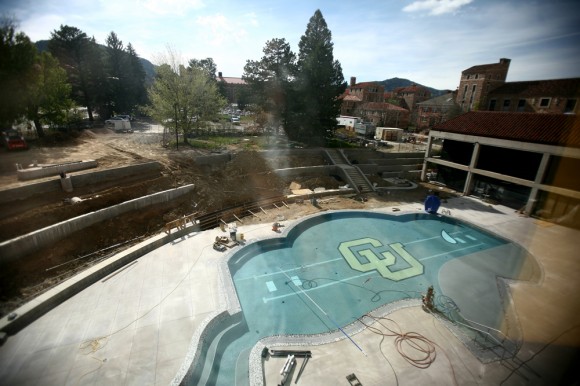
The CU Recreation Center’s outdoor pool, seen here under construction, opened in time for the fall semester. (James Bradbury/CU Independent)
CU’s newly-renovated Recreation Center has encountered the biggest hitch in its construction plans since major parts re-opened to the public last spring.
It’s the cooling system that causes Rec Center officials headaches.
The ice rink and three pools are part of an integrated water system, which produces too much heat as it keeps the ice rink frozen.
“Whenever you’re making ice, you’re creating heat,” said Gary Chadwick, director of recreation services at CU. “The Rec Center runs that extra heat through a heat exchanger, taking hot water to the two indoor and one outdoor pool. But right now we have more heat than the pools can take.”
Engineers discovered the problem during the summer. As a temporary solution, they turned the excess heat back into the air ventilation system, which made the Rec Center uncomfortably hot.
Trial and error
Now that they’ve gotten past the summer, engineers and Rec Center officials have until the middle of spring semester to come up with an affordable fix.
“We’re taking our time to investigate the best solution for the summer,” said Ellesse Spaeth, a senior civil engineering major and chair of recreation services at CU. “This whole winter we’ll be making sure we have a solution that’s adequate and financially responsible.”
The Rec Center now finds itself in a trial-and-error period. Once the engineers come up with a fix, the contractor has to come back and tweak the air and water ventilation systems to make them more efficient.
One possibility is the addition of a cooling tower. It was mid-summer when the heating problem evolved, so Rec Center engineers were unable to find any available cooling towers to rent as a rapid response.
The engineer squad also looks at the possibility of bringing in chilled water to cool the hot water through a mixing valve, regulating the temperature that way.
“What we’re trying to do is gain platinum LEED Certification,” Chadwick said. The certification program is run by the U.S. Green Building Council. According to its website, “[Leadership in Energy and Environmental Design] promotes sustainable building and development practices through a suite of rating systems that recognize projects that implement strategies for better environmental and health performance.”
The long-term plan was and still is to create a cheaper and more efficient system in which the pools depend on the ice rink to get their heat, while the ice rink depends on the pools to take its heat away.
Funding still uncertain
The big question is: Who is going to pay for the fixes?
Chadwick said it won’t be the students. Already, more than $100 in fees per student per semester cover Rec Center expenses.
“We’re looking at the pots of money we have with the Rec Center fund balance, and if there’s any other projects that we have to put on hold, we don’t know that yet,” he said. “It just depends on how much money it is.”
Chadwick tried to control the damage. “The logistics of a phased project mean there were a lot of things that weren’t anticipated,” he said. “It really is a matter of: Now that [the system] is here, let’s see how it really works. These systems all have their own personalities. You can do all the calculations and formulas, but you’re still going to have to tweak it.”
CU students don’t seem to be all to worried about potentially looming extra costs.
“I’d rather not pay for the Rec Center’s mistakes, but I haven’t even noticed the student fees I already pay for,” said sophomore Geoffrey Garner, a 19-year-old Spanish major. “It seems like a pretty minor cost in the scheme of things, at least if all of us shoulder it.”
“I think they had this coming,” said Maggie Mcloughlin, 21, a senior history major. “They made this whole Rec Center project really central to CU’s whole fit and athletic campus image. It’s not surprising that CU has to dish out more for being so ambitious.”
Contact CU Independent Staff Writer Gabriel Larsen-Santos at Gabriel.larsen@colorado.edu.
